On the Midway With the Carnival Game Investigators Out to Protect Your Summer Fun
Step right up!
Don’t look now,” he murmurs. Richard Margittay’s tone is conspiratorial—urgent, a little electric.
We’re facing each other, as if about to dance. I search for his eyes behind his sunglasses, or for the reflection of whatever has him so excited. He’s peering at something over my right shoulder. I’m not quite sure what he sees, but I’m curious.
It’s a Sunday morning and Margittay and I are wandering the midway of the Michigan State Fair. The event is among the oldest of its kind in America—it debuted in 1849, eight years after New York’s—and though it left its traditional fairgrounds in Detroit for smaller, suburban digs, it still delivers the standard fare. There’s a sprawling parking lot, a striped circus tent, and a buzzing exhibition hall where the air smells like damp sawdust and one can find pickle-flavored fudge, plump pumpkins, and prize-winning steer. Out on the midway, beneath the taffy-colored gondolas of a largely empty Ferris wheel, tents and stands peddle deep-fried Oreos and neon-colored slushies. A tinny soundtrack mingles with shrieks of delight and fear.
Like any fair worth its ribbon, this one has games—one after another, operating out of trailers or tents. Some invite players to shoot pellets or fling darts, others to lob basketballs through a hoop or hurl baseballs at a tidy stack of bottles. They’re fringed with blinking lights, and their operators all exhort passersby to “Step right up!” to which many grumble that there’s just no use in trying. They know that those hefty plush prizes—from golden-horned unicorns to parrots dressed as pirates—probably aren’t going anywhere.
Beneath clouds that look every bit like spun sugar, Margittay and I do-si-do. Over his shoulder, I see what had arrested his attention: A game that invites players to “Pitch till you win.”
The task is to toss a ring around a post from a few feet away. The premise sounds simple, but it’s not: The targets aren’t round—many of them are shaped like a rowboat, narrow on one side and chunky on the other. They’re draped with fake leis and prizes—plush animals, cinched at the waist, or pieces of paper trumpeting different things that could be yours. One post holds a few $20 bills, gone limp in the heat.
“That’s a bad game right there,” Margittay says. “I’m gonna get a picture of that before I leave.” He sounds both disdainful and energized. The way some kids perk up when they see a ride or a pile of chili fries—that’s how Margittay gets when he suspects shenanigans.
He sniffs out more at a nearby game. It’s a cluster of glass bottles—champagne, beer, soda—surrounded by sparkling shards of busted ones. Five dollars gets you three throws of a—well, the game operator insists they’re baseballs. If you break two bottles in a row, you win a prize. “I know baseball,” Margittay mutters as we wander off. “That’s no baseball.” He has six fresh stitches on his lip from taking a ball to the face in his 65-and-older league. He knows what a baseball or softball ought to weigh.
We don’t walk far without stopping again, this time at a shooting gallery, where the goal is to riddle a small piece of paper with enough pellets to completely obliterate a little red star at the center. Examples, labeled with the date they were vanquished, are posted around the booth. These are both trophies and ads, designed to convince us that the game is possible to win, and that we ought to try. The operator wants to know: Are we ready? Margittay has a proposition for him. “You can do it, I’ll do it,” he says. The guy demurs—he says he’s never tried. “It’s all a bunch of baloney,” Margittay says, as we move on.
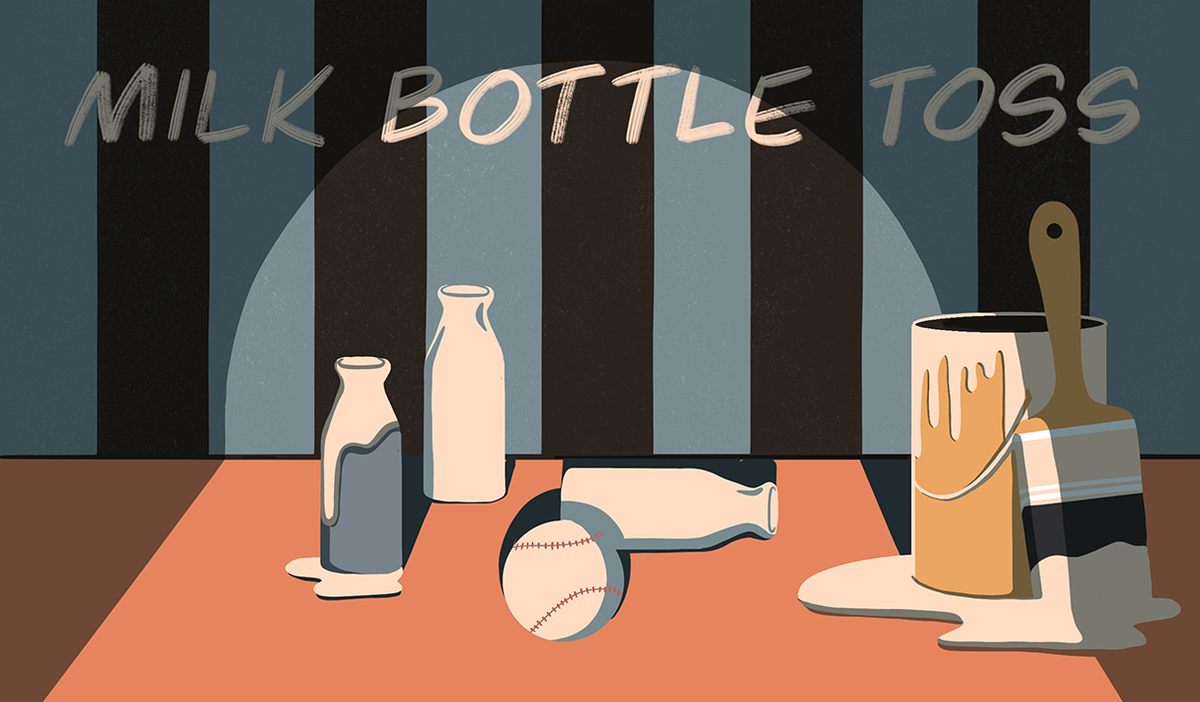
Margittay wants to hover, unnoticed. But like the wasps buzzing around cast-off elephant ears, he’s not especially subtle. His fingers often drift to his belt loops, where his T-shirt drapes over a digital camera case worn like a holster. (His small-barrel Smith & Wesson, he says, is in the car.) All morning, he draws the camera quick and returns it just as fast, snapping scores of photos without spending much time framing or focusing them.
A retired police officer in Dearborn, Michigan, Margittay has found a second act as a crusader, and his cause is to root out, expose, and rid the world of shifty carnival games. He can’t stand when fraud stands in the way of fun. So in the place of fun, when he visits a fair, he collects evidence.
The games clamoring for eyeballs and dollars in carnival midways, beachside boardwalks, or arcades may look different from one another—some require an operator who takes your money and hands over balls, darts, or other implements, while others, such as claw machines, are more automatic—but all tend to have several things in common. They typically cost no more than a few bucks to play, and they are universally hard to beat. And when players do manage to get something out of them, the winnings are most often cheap trinkets. Many of these amusement games, explains business law scholar J. Royce Fichtner in an article in the Drake Law Review, are technically a form of gambling, partly because the outcome is more based on chance than skill. (For instance, in the dart-and-balloon game, the prizes listed under each balloon are often placed at random, so even a professional dart player is as likely as everyone else to come away with a bantam prize.) In many cases, only after many tries and many tiny little victories, does a player have the chance to compete for the bigger, more attractive thing that caught her eye in the first place. There’s a general understanding that the vast majority of players won’t ever get there.
Almost ever since games popped up on American midways in the 19th century, people have fretted over them. Amusement games have erupted as a cultural battleground, again and again, for ethics, values, and Americanness itself.
Long before investigators—including Margittay and some more official ones we’ll get to later—started combing midways for egregiously rigged games, the hand-wringing was about their sheer existence, and whether the fun they provided was too frivolous and a threat to the fabric of rural America. The state fairs as we know them today—crammed with rides, games, and butter sculptures—were preceded by more humble, local gatherings. In the 19th century, when they arose around the country, summertime fairs were often hosted by agricultural societies, which designed them to be educational. They rewarded labor and ingenuity, and were a place to swap practical tips and learn about new innovations. By the mid-1800s, though, some fair organizers suspected that they could bring more people in if things were just a little bit jazzier.
These financial considerations eventually persuaded many ardent agriculturalists that adding other sorts of amusements wouldn’t be so bad. After all, even visitors lured by the promise of something frothy would still be exposed to the agricultural displays.
Not everyone agreed. As historian Chris Rasmussen writes in Carnival in the Countryside, a study of the Iowa State Fair, “the uneasiness or outright antipathy that some agriculturalists, journalists, and fairgoers felt toward entertainments was not merely a cranky outburst against the prospect that someone might actually have fun at the fair.” Instead, it was about identity and what a community ought to stand for. “As Iowans debated the respective place of agriculture and entertainments at the fair between the 1850s and the turn of the twentieth century,” Rasmussen writes, “they were implicitly discussing the future of their state.”
Many agriculturalists considered the games—along with circus performers, musical acts, and other diversions—to be “the opposite of everything that the fair officially existed to promote,” Rasmussen writes. Fairs should be about supporting the agriculture business and its future, including rewarding kids for taking an interest in breeding the hardiest stock or coaxing the most robust squash from the soil. Plus, Rasmussen writes, the anti-entertainment camp was worried about a flood of snake-oil salesmen, pickpockets, and other petty crooks eager to prey on distracted, money-bearing crowds. Ahead of a fair’s opening day in 1875, Rasmussen reports, Iowa’s Daily Gate City newspaper warned locals to “fasten your windows, diet your dogs to a condition of ravenousness, and above all keep your revolvers in good working order.”

Underpinning all of this was the fear that the games and their operators were just cheating hardworking, good-hearted folks out for a good time. In August 1937, the Democrat and Chronicle in Rochester, New York, ran a full-page pictorial spread under the headline, “You Haven’t Got a Chance.” The photos demonstrated the ways common amusements could be set up in the operator’s favor—including plants in the crowd—and declared, “when you play the sucker games on the midway at a fair or carnival, you’re bound to lose.” There was something sour and bitter about the notion that summer fun could be reduced to a seedy transaction between an operator’s eagerness to deceive and a player’s willingness to go along with it.
First, Sergeant George Scharf was mystified. It was spring 1939, and he was whiling away an April day at a local carnival in Detroit. There, he found himself glued to a game in which players hurled baseballs to knock down a cluster of four bottles. Five cents got a player three balls, weighing four ounces apiece. Scharf watched one player after another try. Time and again, three of the bottles toppled with ease and the fourth was stubborn. He watched until he couldn’t take it anymore. “The obstinacy of the fourth bottle at last became such an obsession with Scharf,” the Detroit Free Press reported at the time, “that he climbed over the barrier and hefted it.”
And no wonder. The bottle Scharf grabbed wasn’t wood, like the others—it was iron and filled with lead. It weighed 7.5 pounds, basically impossible to drop with a four-ounce ball short of launching it from a cannon. Scharf marched the offending “bottle” to a police station a block away. When he got back to the carnival, he saw that players seemed to be having a much easier go of it.
Eighty years later, there are still many ways to manipulate the outcome of a game, from physical funny business to psychological sneakiness. An operator might tinker with the objects of the game—heavy bottles, light balls, dull darts, crooked sights, basketball hoops bent into an ovoid shape. In the case of automated games, owners or manufacturers may fiddle with the back end, programming a claw’s grip to be too weak to lift many of the prizes, or to hold them long enough to make it to the prize bin. Or operators may use psychological tactics, such as promising a player that another $3 will get them closer to victory, even though, statistically, the chances of winning are just as low every time around. Several decades ago, Fichtner reports, FBI investigators tried to crack the secrets of a common game in which players try to toss a ring into a field of bottles to get it to land around the neck of one. In one test, they found it took 583 attempts to get the ring to land—and that one was only because of a lucky ricochet. In another test, it took more than 700 tries. (At $5 a play, that’s $3,500.)
There’s a simple reason operators have wanted to make their games hard to win but look easy: economics. In a 1997 article in the FBI’s Law Enforcement Bulletin, former investigator Bruce Walstad, who then worked in the police department in Franklin Park, Illinois, breaks down the financial structure of midway amusements. Game operators often pay carnival operators a daily fee, known as a “privilege,” for a spot on the midway, he writes. The figure depends on the size and location of the lot. (The prime real estate is toward the front, on the right-hand side, Walstad notes, where operators can expect the most foot traffic.) From there, fees keep mounting. “Dings” go toward things such as hooking up electricity, Walstad writes, then there’s so-called “fuzz” money, allegedly funneled toward hushing complaints, or as a balm for scratchy relationships with politicians or other officials who don’t like what they see. They also have to pay for the prizes upfront, and their own expenses on the road.
Walstad crunched the numbers for a game at the Florida Mid-State Fair. The operator of a bushel-basket game (toss a softball into a tilted basket and get it to stay there) in a 20-foot trailer set up shop for 11 days at the cost of $1,600 per day. Just to break even, he would need to entice 3,520 plays at $5 each. At the Michigan fair, one operator, who asked to remain anonymous for fear of retribution, told me that he needed to rig his game—he bent his basketball hoop to keep balls from passing through easily—to turn a profit. “If I put up regular rims up there,” he said, “I’d have to park a semi behind me to keep up with the stock I’d be [handing] out.”
The Michigan State Fair doesn’t have any formal sweeps in place to identify games that have been manipulated. “If the question is, do we as the fair inspect every game, the answer is no,” says Steve Masters, the fair’s executive director, and a former game operator himself. “But by driving around, we can see what’s happening,” he adds. Masters says that, to his knowledge, the games at the fair are all games of skill or prize-every-time games—not gambling. He would “certainly never knowingly allow” a manipulated game on the midway, he adds. “We are working to create a family environment and a friendly environment. Customer confidence is part of what we’re trying to do here.”
In his Drake Law Review article, Fichtner, the legal scholar, points out that it’s no secret that many games have historically been tampered with. Even in such cases, or ones in which a game definitely fits the legal definition of gambling in a place where that’s prohibited, that doesn’t mean anyone will be prosecuted, “possibly because carnival games constitute minor infractions that have persisted for so long that there is little incentive to start prosecuting them now,” he writes.
It’s hard for anyone to win at a carnival or fair midway, or out on the boardwalk, but both individuals and official agencies are out there trying to make sure it’s not impossible.

In the 1930s, Scharf, the Detroit sergeant, hated to see something sneaky going on so close to a police station. Decades later, Margittay, the former Dearborn cop, felt the same way. To hear him tell it, he was sitting at the front desk one day in the 1970s, writing up some reports, when someone came in to complain that they’d been ripped off at a carnival near the station. Margittay had strolled through with his girlfriend the night before, and he thought something seemed off. But right under the cops’ noses? That rubbed Margittay the wrong way, and it still does. These days, he is a lone wolf—propelled by a mission, but without power to enforce it, since he’s retired. He scopes out carnivals in between gigs photographing sports, or cruising in his 1948 Willys Jeep with his fluffy, friendly Alaskan malamutes. When Margittay takes matters into his own hands—by bringing complaints to the police or railing against operators in writing—he sometimes winds up in hot water: In 2012, a carnival company sued him for defamation, citing claims he made about their practices in his two self-published books. (A U.S. district judge dismissed the suit in 2013.)
While Margittay is a volunteer inspector, elsewhere there are people authorized to canvass for rigged games. On the sun-drenched New Jersey boardwalks, that task often falls to Joseph Chessere.
Seaside Heights, New Jersey, lives up to the promise of its name. Its streets are lined with low-slung beach houses and on-brand dives—the Surfside Motel, the Shore Thing Pub. Porches are speckled with beach chairs facing the ocean, even if there’s another building in the way. Swim trunks and towels drip over railings and flap like sails in the breeze.
On a mid-July afternoon in 2018, with thunder rolling in the distance, I meet Joseph Chessere on the boardwalk, where visitors can buy fried clams or an iced latte from Bada Bean Cawfee, where a dash of espresso is known as “a single shot to the head.” There are dozens of games scattered along the boardwalk and in oceanfront arcades—from balloon dart games to wheel-spinning games to claw machines—and Chessere’s job is to make sure that it’s at least possible to win them.
Chessere has a warm face and deep, crème-brûlée tan, and today, he’s wearing a uniform—a collared, dark navy polo with a yellow-gold seal on the upper left. Normally, though, he keeps a low profile—and a change of clothes in the car, in case someone recognizes him.
Given his druthers, he’d rather be out when the boardwalk is thronged with crowds. That’s when it’s easiest to blend in among the sunscreen-smeared masses. He doesn’t want to be detected until he flashes his badge, which is folded into a leather case with a metal insignia. “If I’m wearing a suit, [people] know I’m not on vacation,” he says.
He is an investigator with New Jersey’s Legalized Games of Chance Control Commission (LGCCC), a unit within the Department of Consumer Affairs, and uniquely equipped to be quite good at it. Before he started working as an investigator around 15 years ago, Chessere spent six years as a software engineer at an independent lab, he tells me, where he looked at amusements games’ guts. He says he left the lab, which was a small operation, for a more secure job with the state. He knows how games work, from the inside out—and that helps him detect anything awry.
The state has been licensing amusement games since 1959, first under the umbrella of the Division of Alcoholic Beverage Control, and within the Division of Consumer Affairs (DCA) since the 1990s. All summer long, Chessere and his colleagues follow up on complaints made to the DCA about boardwalk games. (The division acts on every one, he says, and each of the state’s 266 amusement game licensees in shore resort areas get a drop-in at least once a year.) When the DCA first took over enforcement, “It was more Wild West,” says executive officer Karl Reidel. Now, he says, “It’s closer to where licensees want to work with us—they understand that we’re not going away.”
At Lucky Leo’s, a sprawling arcade complex festooned with tinsel, ornaments, and candy canes for a Christmas-in-July promotion, Chessere demonstrates to me and a few other reporters how he might approach a claw game to see if it was rigged. Prizes have to be light enough for a claw to grab, and big enough not to slip through its fingers. If all of the big-ticket prizes from a claw game are outside of the playing field, that’s a violation. Chessere slides the claw to the right side of the game, and goes for a velvet bag. He’s got skills—he grabs it on the first attempt. When it drops to the slot, he fishes it out and opens it up to check for the prize inside. All good. Chessere says he’ll sometimes do a 50-play test on a game, just to see the range of prizes and confirm its consistency.
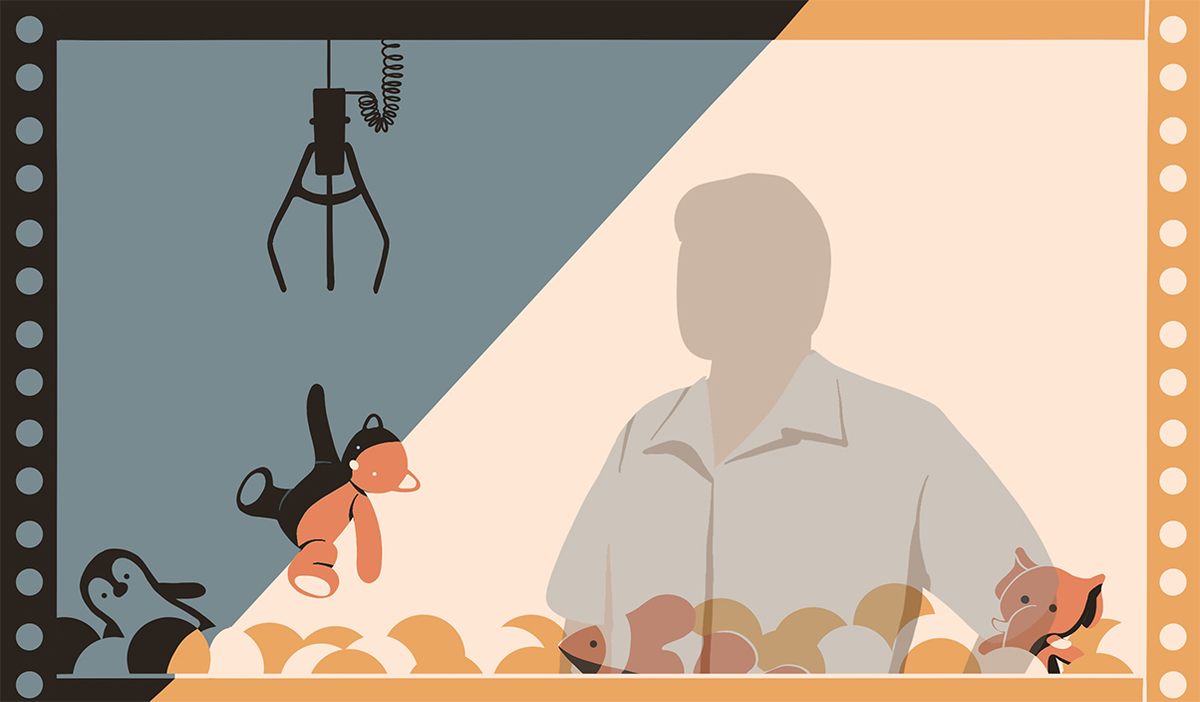
He also opens the machine up and checks a little box inside. It should include a line saying that the game is certified for play in New Jersey. “No one is allowed to manufacture their own game and put it in here like ‘Mu wha ha ha,’” says Kelly Whalen, manager of Lucky Leo’s, miming an evil cackle. “Things that weren’t approved for New Jersey won’t be here.”
If a game is found to be in violation of state regulations, the goal is that “it gets corrected before I leave,” Chessere says. When that’s not possible, he shuts it down. I imagine that this isn’t always popular with the operators, but Chessere won’t say anything more. “Everybody’s happy; it goes over well,” he says, halfway between a smirk and a grimace.
Chessere’s practice aligns pretty neatly with a primer outlined by Walstad, the former investigator, in the FBI Law Enforcement Bulletin. An investigator ought to get the full, transparent spiel from operators, Walstad writes. Which prizes are there, and how does a player win them? What’s the formula for trading up from the shrimpy prizes to the bigger ones? The operator should climb over the counter and demonstrate the game from the player’s position, to prove that the players have a shot at winning—that the rings fit over the blocks, the balls can splash through the hoop, the darts are sharp enough to pop a slightly deflated balloon. If everything checks out, Walstad writes, “One of the inspecting officers should explain to operators that the rules and props cannot be changed or altered, that they may not move to another midway location, and that they must operate the game as it was explained and recorded during inspection.” No reverting to funny business once the officer has moved on.
“We don’t want anyone walking away from what should be an enjoyable trip feeling like they, or worse, their children, were taken advantage of by rigged games or deceptive sales practices,” New Jersey’s Attorney General Gurbir S. Grewal said in a statement when the Commission announced their 2018 sweeps.
Still, the Commission puts a bit of the onus on consumers, too. Their website reminds players to look for operators’ licenses and posted rules, and states, “If you think you are being cheated, stop playing and walk away,” then file a complaint. “Consumers have to know what they’re willing to spend,” Chessere says. A player with dismal hand-eye coordination, then, shouldn’t approach a hoop game with Stephen Curry delusions. “If you don’t want to spend $50 and you’re not that good at basketball,” he adds, “maybe pick a different game.” We’ll help ensure that everything is legal, he’s essentially saying, but no one is prying sea-dampened dollars from your hands.
New Jersey’s LGCCC has issued more than 183 citations since 2014 (with final counts for 2018 and 2019 on the way) for several kinds of violations, from prizes that were too packed together to be grabbable to ones too heavy to be budged. One official told me that, in the past, they’d found handbags that were impossible to pluck from claw games because they were weighed down with rocks. Other regulations state that in New Jersey, no game can cost more than $10 per play, and a prize can’t exceed $10,000 in value. First-time violators are slapped with a fine of up to $250. For repeat offenders, it can grow to $500.
There’s been some push among operators and manufacturers themselves to bring the games above board, as well. This is partly led by the American Amusement Machine Association, a trade organization. Its new code of conduct, effective as of December 2018, stipulates that players can expect to hone a skill, which will “improve with practice and experience,” and that their actions will “influence the outcome of the game.” All of the group’s 200 or so members—manufacturers, distributors, and suppliers of pay-to-play games—are expected to comply, says executive vice president Peter Gustafson.
But Margittay, Chessere, and other anti-scam crusaders can’t save us from our impulses—they can only try to prevent game creators and operators from preying on them.
The trouble is, whether winning is just unlikely or truly impossible, people play anyway. Some are in it for entertainment or the quiet thrill of low-stakes, long-shot odds. I met a player like that at the Michigan State Fair—a tall, trim teenager with a University of Michigan T-shirt and swooping hair. He stepped up to a bottle-toppling game, took them out on the first try, and walked away with $40 cash. His name is Nathan Williams; he was 14 at the time and an athlete. When Margittay and I caught up with him near a game where you lob a ball into fish bowls to win a fish, he explained that he didn’t have a strategy, exactly—he just got a bit lucky. (Margittay suspected that operator goofed, and inadvertently organized the bottles in the player’s favor instead of staggering them.)
Other players knew they were kissing their money goodbye, and didn’t mind. In Michigan, I met Paul Lechevalier, posted at a coin-sweeping game, entranced. As I watched, he fed more and more tokens into the machine, which rakes the loot and other little prizes toward the player with the idea that one more coin dropping to the playing field might be enough to send an avalanche of loot into his hands. Lechevalier hadn’t won big yet—he and his family were out more than $40, all told—but he didn’t care.
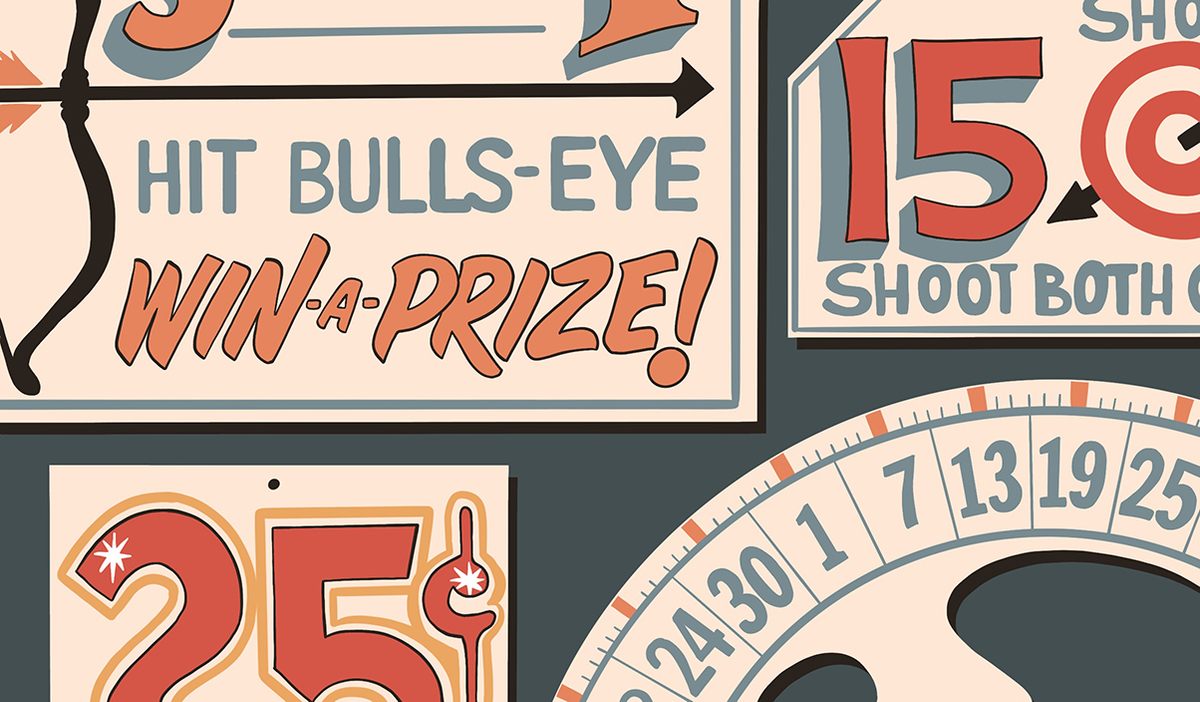
“We come every year,” he said. “We like to gamble, and this is the closest thing to gambling there is.” He pointed to a little sign on the game: “Fun Matters!” with the last word underlined twice. (Another read: “Warning: Addictive,” with two exclamation points and one smiley face. “It sure is,” Lechevalier said.) He knew there was no way to win, he said, but they were “playing for the heck of it,” for the “thrill of the chase,” and to pregame for a trip to a casino in downtown Detroit later that night. “That’s when it’s go time,” he laughed. Between himself, an uncle, and a cousin, he figured they would spend somewhere between $1,200 and $1,500 that day on games at the fair and casino—not enough that they’d really miss it, he said, but enough that he thought they stood a chance at making it all back, and then some.
When I asked if he might feel gambled out after such a long stretch, he scrunched up his face and laughed. He stopped only long enough to repeat my question to a guy he introduced as Uncle Bobby. “She wants to know if we’ll be gambled out!” he called. “Ha! No.”
Still others play for the nostalgia—you only get so many summers, and you might as well spend them making memories with your kids. In New Jersey, I slowed when I saw darts piling up in front of a balloon-dart game. I watched as a towheaded kid flung one after another. The kid’s mom nodded at me. “Keep walking,” she said. “We just spent $20 on this Pikachu.”
The three of us—Julie Kleedorfer, four-year-old Aiden, and I—sat down for a few minutes on a wooden bench facing the darkening sea. They had arrived earlier that afternoon from Leesport, Pennsylvania. Kleedorfer had set a daily budget for their six-day vacation, but they were already tearing through it: They’d only been at the shore for a couple of hours and they’d spent $50 on games.
Aiden wriggled in his mother’s lap. He was wearing a green Mario Kart T-shirt, and he wanted to play with his new plush Luigi, just one from a shopping bag of cuddly critters—a penguin, a pink turtle with dreamy eyes. Kleedorfer had won a necklace—gold mardi gras beads, which she’d already looped around her neck. It was a cute haul, but it didn’t come anywhere close to $50 in value. “I can’t afford to spend another $10 on something stupid,” she told me, as Aiden asked if they could play again. But as a single mom, “Coming down here and trying to make him happy is a project.”
Whether you’re a kid or an adult, the midway or the boardwalk, with their flood of lights, sounds, and smells, are built to be playful and disorienting and transfixing. Yanking your attention, then clinging to it—that’s the job of both operator and design. As a player, you’re constantly recalibrating, trying to gauge the value of the prize versus the value of the experience versus the value of the money in your pocket.
It’s a shifting arithmetic. I saw that in action on the New Jersey boardwalk, when I came across a bunch of people huddled around a game I didn’t quite understand.
I asked about the rules and tried to make sense of posted signs, and this is what I surmised: Players handed over $2 for three tokens, which they could place anywhere on a board that was labeled with words and symbols. Someone pressed a little button that spun and stopped an electric wheel, something like roulette, only without odds you can count on. If the wheel’s arrow stopped on a something corresponding to where players had placed their tokens, they won. There were bigger prizes in a pile that recalled a department store’s clearance section: fishing rods, scooters, and pots and pans, a family-sized electric griddle, a set of knives.
I wasn’t exactly sure how to win the scooter, and it seemed that the players didn’t totally grasp the rules, either. “We’re figuring it out,” one woman told me, as she counted out crisp bills with her manicured nails.
But I understood the appeal. The premise seemed simple, the buy-in low, the prizes desirable. I’m not sure who, if anyone, won the rods or the griddle or anything else. All three of the players I watched went bust, and I hurried to the car before I could convince myself that I could walk away with something valuable for a couple of bucks—just before the rain began to splatter onto the boardwalk.
Have you ever played a carnival game that felt more than a little unfair? Tell us about it and discuss the story in our Community forums!
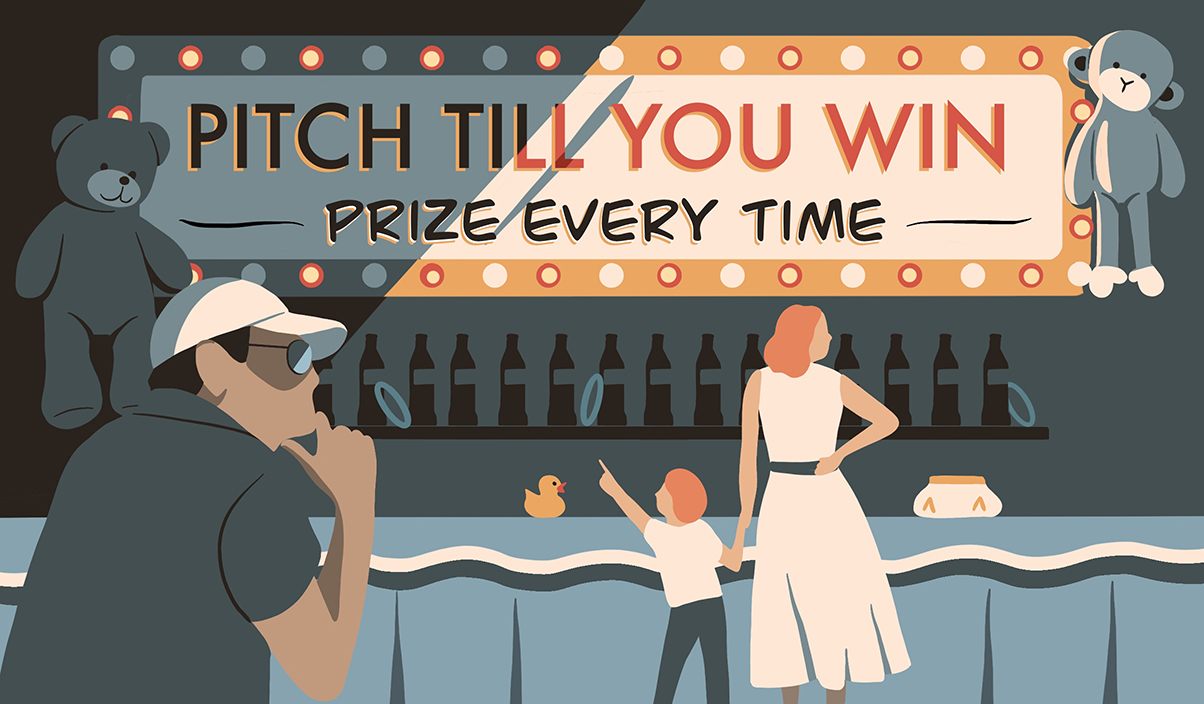




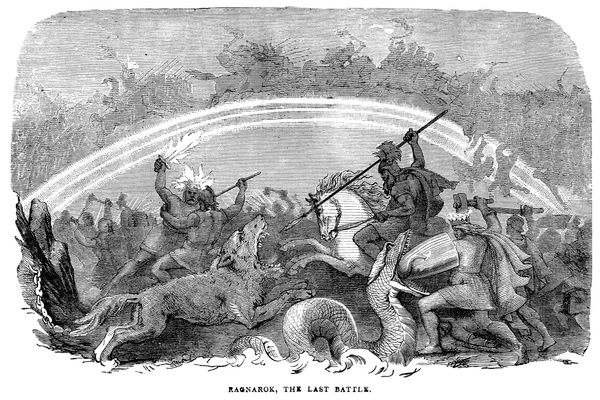














Follow us on Twitter to get the latest on the world's hidden wonders.
Like us on Facebook to get the latest on the world's hidden wonders.
Follow us on Twitter Like us on Facebook